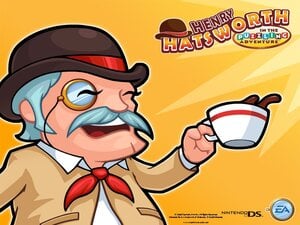
If you've read our review then you'll know that Henry Hatsworth in the Puzzling Adventure is one of the most creative and fun games you can play on the DS right now; the blissful combination of gorgeous 2D visuals, top-quality platforming action and brain-bending puzzle gaming really is a joy to behold. The biggest surprise is that it's published by EA - a company usually associated with big-name, low-effort franchises.
We tracked down Kyle Gray - the mastermind behind the game and the creator of everyone's favourite hat-sporting, tea-drinking explorer - in order to find out more about this excellent slice of software, how it was created and what the future holds for him now he's parted company with EA. Stand by for a rollercoaster of an exclusive interview!
Subscribe to Nintendo Life on YouTube841k
Nintendo Life: Before we get stuck into talking Hatsworth, what’s all this we’ve heard about you leaving EA and going indie?
Kyle Gray: It’s true! I ended up leaving EA on tax day last month and got married to my long time fiancé less than an hour later. True story.
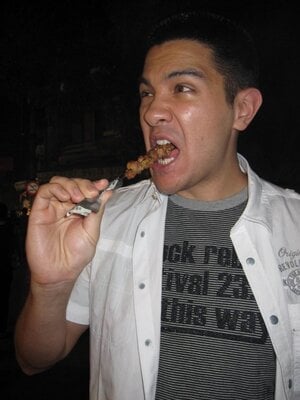
After the honeymoon I came back and started my new life as an indie developer. It’s been an exciting, albeit short ride thus far – mostly consisting of me and a good buddy struggling to assemble IKEA furniture into the rough semblances of an office.
That and fighting off cabin fever.
I guess that’s why so many famous indie developers hit up the coffee shops – there’s some sort of bizarre coffee culture camaraderie out there that you’re just not aware of when you work in the cubicle scene. Plus where else can you sit for 4 hours and plumb the depths of the internet all for the low, low price of one endlessly refillable cup of coffee?
Nlife: We heard you left an interesting farewell message for your EA colleagues – what kind of reaction did it get?
KG: I ended up making an animation based on the famous Bugs Bunny tap dancing scene from “Bugs Bunny Rides Again.” So far I haven’t heard any comments other than from an animator friend of mine who said it looked cool.
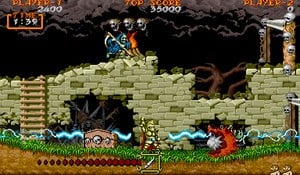
He was probably being generous though – I’m a pretty crappy animator when it comes down to it.
Nlife: EA is mostly known for its monster franchises these days. Was it hard getting permission to produce Hatsworth?
KG: Surprisingly, it wasn’t too bad! I initially pitched the swell gents at Tiburon with a project idea which basically involved me doing some crazy stuff in Flash on my own. Luckily, they totally approved it, so I started making little DS game prototypes– which gradually led to the Monkey Business prototype, which ultimately became Hatsworth.
Not to say that there weren’t any setbacks – we ran into our fair share of problems, but the studio head was really supportive and continued to fund us until we got green lit by the Casual Label.
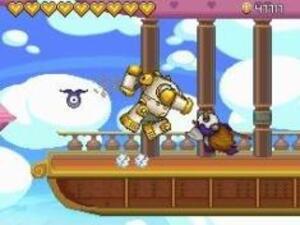
I think it helped that the game and pitch was pretty weird – I had an old dude jumping into a mech suit version of Big Ben and a pitch that largely revolved around the exploits of Christopher Columbus. Any time you mix Briticisms with old school Spanish explorers you know only good things will happen!
Nlife: Why did you want to make an indie style game at a major publisher like EA when many others would have stayed in their Madden themed comfort zone?
KG: I was weaned on the likes of Looney Tunes, Scooby Doo, Masterpiece Theatre, and Mystery. The only sports I ever played were tennis, swimming, fencing, and crew.
Ours was a non-sports household, so I’ve only ever watched the Super Bowl for the commercials. I didn’t even understand what a 2-point conversion was until sometime in the last 6 years – so it was probably all for the best.
Nlife: So now that you have officially gone indie will you be trying your hand at WiiWare, DSiWare or iPhone development?
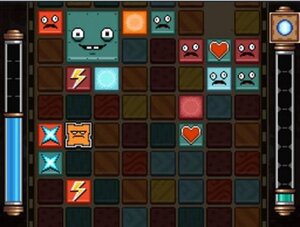
KG: Why not all of them? One of the reasons I left is because these amazing development environments exist, where it’s suddenly become possible to once again make a game with only 2 or 3 people.
Since I left I’ve been talking with a friend about making an iPhone game and have started working on a WiiWare title with my good friends Kyle Gabler and Allan Blomquist – who you might know from the excellent WiiWare game, World of Goo!
Nlife: Can you tell our readers more about your friendship with Kyle Gabler from 2D Boy and your plans for the Experimental Game Project?
KG: Kyle and I come from similarly eerie backgrounds – so much so that I unsuccessfully tried to brand him as “Evil Kyle” back in grad school. People caught on pretty quickly, however, and dubbed me “Eviler Kyle.” We’ve been friends ever since.
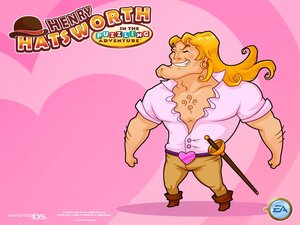
As for EGP – well, we’re looking at re-launching the site and returning to make the occasional 7-day prototype as well as doing some new things. I’m really looking forward to making games for it again.
Nlife: Moving on to Hatsworth, was it the commercial success you hoped it might be?
KG: When I was in Hong Kong last month I actually saw a copy of the game in an obscure little store that also sold T-shirts and little jade Buddha statues. That was immensely gratifying.
I’d love to see a copy of the old boy’s game in every DS, but thus far I have yet to see someone else play it. One day I hope to peer over someone’s shoulder and find them playing Hatsworth, but then I’d probably weird them out by giving them too many tips or something.
Nlife: How many people worked on Hatsworth in total?
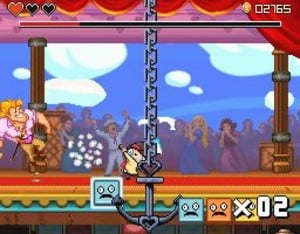
KG: The core team consisted of 7 people total: 3 designers, 2 programmers, and 2 artists. Luckily everyone was really good at what they did! Oh, and we also had some really talented composers on the music side of things. There was also our Executive Producer, who shielded us from afar from all sorts of game development dangers.
Nlife: Henry Hatsworth is a quintessential English gentleman explorer. Did characters such as Phileas Fogg inspire his creation?
KG: It’s actually kind of weird how Hatsworth came to be. When I was making the initial flash prototype I wanted to showcase the mechanic more than anything else. At the time I was reading a lot of artist’s blogs and this one image of a block-shaped gorilla burned itself into my brain, so I immediately started making an army of sophisticated hat-sporting primates! Who better to exterminate these dangerous primates then a Briticism-spouting explorer in a pith helmet?
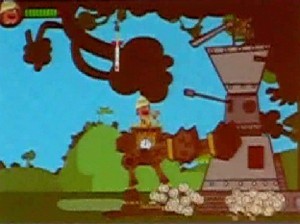
Later, when I started writing the story I borrowed heavily from different characters from my childhood like Scrooge McDuck, Indiana Jones, and Mr. Magoo. There were also definite influences from the likes of Sir Arthur Conan Doyle, Oscar Wilde, and Jules Verne.
So yeah, Hatsworth is a melting pot of British archetypes all wrapped into one suave and sophisticated package.
Nlife: It’s plain to see that the art direction and music is of top-notch quality in Hatsworth. How did you ensure the game would stand out from the more generic platformers on the DS?
KG: By finding the best talent and focusing it in the direction of ludicrousness!
How do you combine a platformer with a puzzle game in a story? You could use the puzzle as a metaphor, but I for one have always been a bigger fan of following things to their literal (and logical) conclusion. Hence the over the top, nonsensical romp involving a magical gentleman’s suit and a mystical puzzle realm where all puzzle games live. I mean that totally makes sense, right?
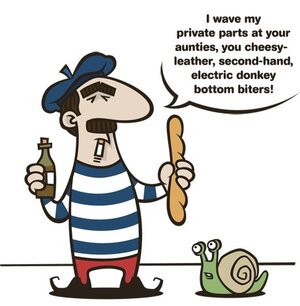
From the sound perspective we pushed the music into forgotten styles of music, with the soundtrack starting in the realms of exotica and space age pop. While only a few tracks maintained this musical flavouring, it helped set the initial tone.
Similarly, we decided to go away from the light musical chiming used in most DS title conversations, in favor of more of an old-school Star Fox/Banjo Kazooie style of voice acting. It was really a hit or miss decision, but I think most people liked it overall – with the exception of Cole’s voice – that little bugger can be annoying. He used to sound a lot worse though – believe you I!
Visually, we tried to stick to an old-school look, building on it with some new concepts. When our art lead, Jay Epperson, finished his work on the Concept Piece for the fabled Puzzle Realm we knew we’d hit a good balance between the new and the familiar. If you haven’t seen any of the concept pieces for the game yet you should really check them out on his blog:
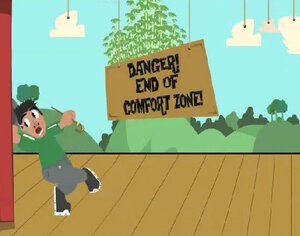
http://jayepperson.blogspot.com
Nlife: Hatsworth makes wonderful use of both screens of the DS. Do you feel that many DS games fail to take advantage of the power of the dual screens?
KG: Initially it seemed like people were really focusing on the stylus and the microphone, but that seems to have changed in the last 2 years. As a player it can be pretty challenging to focus on both screens simultaneous, so I can understand why not many people went the same route as we did (with notable exceptions like “The World Ends With You”).
Nlife: We love a good 2D platformer romp. What games from your childhood influenced the design of the platforming side of things?
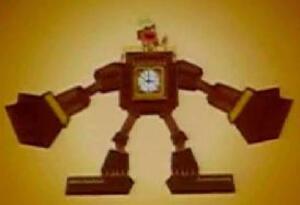
KG: Oh man, this is very nearly a desert island question! My list would have to include Super Mario World, Megaman 2, Ghouls ‘n’ Ghosts, Ducktales, and Megaman X.
Nlife: For those who haven’t played Hatsworth, can you describe the cause-and-effect relationship between the platform and puzzle worlds?
KG: In a nutshell the Puzzle World is there as a resource for the player – properly used it can be a help, but if mismanaged it can be a hindrance. All defeated enemies and items end up in your puzzle, so it’s up to you to use them (or in the case of enemies, get rid of them) when you want.
Puzzle blocks give Hatsworth energy, which he can use to power himself up to his younger state, or cash it all to use his super invincible Robot Suit in a little moment we call “Tea Time!”
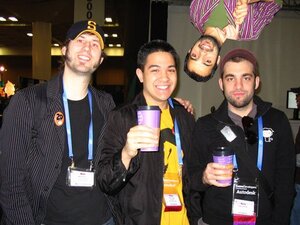
The Puzzle also has numerous affects on the platform: trapped enemies can escape; you can use it to modify your ammo to make you attacks more powerful, it can be used to activate special blocks in the level that the player can jump on - and of course the bosses can mess with it.
Nlife: Is the puzzle game a simple match-3 affair, or is there more to it than meets the eye?
KG: That’s what the puzzle appears to be – but it’s actually a bit deeper than that. Like most puzzle games, Hatsworth has the concept of chains. After making one match-3, the player has a limited amount of time to activate more blocks. The bigger the chain he manages to make, the more Super Meter energy he gets, the more powerful his items become when activated (you’ll notice they start blinking), etc. For instance, when you activate the extra life power-up after a big chain, you’ll actually get more lives!

Oh, and of course bosses and enemies complicate things further. In order to make the puzzle more challenging we created 8 different enemy block types – each of which have a different effect on the puzzle. Some speed up the scroll rate, others spawn more enemies – pretty much everything you can think of.
Nlife: What were the difficulties in getting the interaction between the two aspects of the game to work in harmony?
KG: Initially there were problems finding a puzzle style that would work. We went through numerous iterations before we settled on one that finally did. After we figured that out, the main remaining issues revolved around time or simplicity. Our team managed to crank out a lot of stuff in a relatively short period of time, but there are so many things I would love to add!
The other problem was figuring out how to communicate all of these interactions to the player. A platformer/puzzle game is a little hard to wrap your head around at first and I wanted most of the new stuff to be as intuitive as possible.
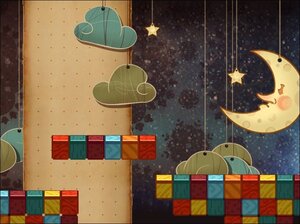
Nlife: Tell us more about Lance Banson - he has to win the award for most bizarre boss in a game ever!
KG: Oh man – where do I go with Lance? For starters, the character was based off of student project I had worked on with some friends back at CMU. In that version he was a zombie exterminator, but still a bit of a schlub with gorgeous blond hair, and a lady-killer smile.
Once Jay started working on his character concept he put his own spin on him – and the team immediately loved his new romance book guy look. Opera also seemed like a good fit, especially given his Gaston-ish nature. Once we had the look it was obvious he’d need groupies, and that he’d have to be extraordinarily shallow.

It all just kind of worked together – especially when our composer, Gene, made Lance’s Aria – that was just a whole new level of insanity.
Nlife: What was your team’s reaction to the idea of giving the old English gent a Metal Slug style robot suit to help him kick ass when needed?
KG: I think they fell under one of two categories, “what the hell is this awesomeness that’s going on?” or “sign me up!” I mean, pretty much everyone loves giant robots – except for possibly women ages 30+, who apparently hate robots. Or at least giant robots.
Actually, “Tea Time” came about before I had a team. At the time I had been working on the aforementioned Monkey Business prototype and decided it needed a Big Ben mech. I showed it to designer Peter Ong (now at Dream Rift) and he didn’t immediately dismiss it as weird – so that was really encouraging!
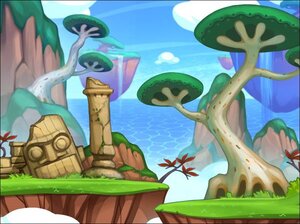
Big Ben is also what initially sold everyone on the game and more or less got us funded – like I said before, just about everyone loves giant robots! I think you can probably still find the Big Ben transformation sequence if you search “Big Ben Mech” or something in Google.
Nlife: Hatsworth has been criticised by some for being too tough later in the game. With hindsight would you have toned down the difficulty if you had a second chance?
KG: As we approached the end, the game saw multiple tuning passes. The problem was that so many of these changes were made in parallel, so no one was quite sure how hard it would end up. In fact, at one point it was actually more difficult than the final version, if you can believe it!
In my ideal world, Hatsworth would have had an “old-school mode” and a normal mode so everyone could beat the thing and see the game’s ending.
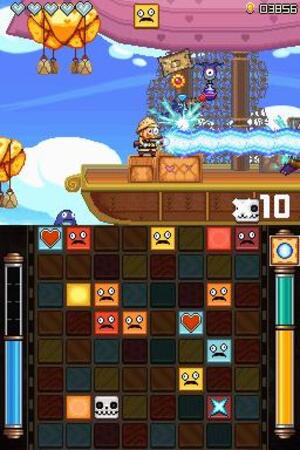
Nlife: If EA wanted to make a Hatsworth sequel would you like to be involved and where do you think Sir Henry could go from here?
KG: If I got a call from EA that gamers were clamouring for a second Hatsworth (call me EA!) then I’d once again don my bowler hat and set to work on the sequel. I think we only managed to scratch the surface of British stereotypes, and I’ve love to broaden out – into French stereotypes, for example!
Nlife: Phew, you must be exhausted now. I know I am! Before you go for ‘tea time’ is there anything else you would like to say to our readers?
KG: I’d like to give a big thanks to everyone who’s picked up Hatsworth! Without your support, strange and different games would not exist and we’d live in a sad, grim reality.
Oh, and I also have a question for you lot out there on the internets: Did you beat the game, and if so were you satisfied with the ending?
Thanks to Kyle G for taking time out of his busy schedule to do this interview with us. Nintendo Life wishes you all the best in your adventures as an indie developer.


Comments 21
I'll be keeping my eye on Mr. Gray's future projects, that's for sure!
Great interview, quite a charismatic figure for sure.
If he's going to be working with 2Dboy, then they all might as well have my money now.
I still need to buy Henry Hatsworth, but I have no doubt it'll be awesome. Can't wait to see what else Kyle will work on.
Thanks everybody, Hatsworth was a blast to work on!
I somehow forgot to mention it, but if you liked the soundtrack you can download the whole thing for free from the game's site: http://henryhatsworth.com.
I haven't even seen it in stores yet...
@KDR_11k - That's interesting, Drake said he couldn't find it in the Netherlands either.
Gameseek ship to Germany and you can pay with PayPal so there is no excuse to miss out on this excellent game now
I picked up Hatsworth on release day and I don't regret it for a second. The difficulty is a bit high for a casual audience, however.
Brilliant game overall!
@ KDR_11k: That's because it wasn't released here in Germany.
@ Game: It received very good scores, and I will definitively buy it in the near future.
It will probably be my next DS purchase--after I get Punch-Out for Wii. I've heard nothing but good things so I'll be getting it for sure!
Great interview, and a truly wonderful game. I've recommended it to a lot of my friends, as the art / music / humor really come together to create a great experience.
A question for Kyle (if he's still hanging around): Was the voice of the female boss with the purple dress and the veil (I forget her name) modelled after Dr. Girlfriend, from the Venture Bros cartoon? It almost sounds like a direct impersonation!
Awesome interview. I'm still looking to buy Hatsworth. So much juicy DS goodness as of late it seems.
I wish more games like this would come to the DS system. We need more originality. This was a fantastic interview.
I just picked up the game recently, and have greatly enjoyed it.
@Kyle (if you're still hanging around)
I've always been a fan of the Puzzle League series of games, going back to Tetris Attack and even the touchscreen-enabled DS iteration. The basic rules of the puzzle mode in Hatsworth are identical, as are the minor nuances with timing (when you can slide a piece as one is falling in order to set up the next chain, etc). Anyhow, combining PL gameplay with a romping, money-grabbing adventure in the vein of a Wario game is a win-win as far as I'm concerned, but I'd love to know what role PL played in early concepts / development, since I don't believe I've seen it mentioned explicitly as the inspiration behind the puzzle mode.
@ Chicken Brutus
Totally - the Venture Brothers is one of the best shows out there right now. Actually all of the character voices were done by one amazingly talented guy. I wish I had his voice!
@ Warioswoods
The first puzzle game we tried in the prototype phase was more similar to Bejeweled Twisted, where you rotate 4 blocks simultaneously - but as the game changed we had to keep trying different puzzle game styles to make the whole thing work. In the end we ended up with a PL style game though with looser chains - which is cool as far as I'm concerned - PPL is an amazing title!
I just want to say that Henry Hatsworth really shocked me- I haven't seen a platformer in a long time. A very unique and challenging one at that. I have the utmost respect for this game and I'm totally up for a second hatsworth, I hope the rest of the fanbase harasses Kyle as well. Easily one of my favorite DS tittles right up there with the long-standing franchises.
Great job with the interview chaps - so many interesting revelations, and he seems like a really good guy who'll no doubt go places. Places we all want to hear about!
@ Kyle,
just want to let you know I'll be picking it up, despite being in Australia. If I may ask, why is it not being released down here? Is it due to fact that too many people have flash cards? Most people I know have them - including myself, but before you judge me the closest thing I've got to piracy on there is a GBC emulator and Pokemon Crystal or Bratz Ponyz 2, (just to see how easy it is to load on ROMs and the devs deserve it anyway); I mainly use it for homebrew. All the flash cards a real shame actually. Hopefully the DS2 will have SNES-like processor-on-a-chips. That will stop the pirates.
Anyway, anyone looking to buy: http://365games.co.uk/index.php?productID=4627 ship anywhere in the world for under 1 pound. And the Aussie dollar is hugely mega now, so cheap games for sposchy! (and if you happen to be in Melbourne you may just see me playing it)
@Kyle G:
Go team Hatsworth.
@ Esposch2
I wish I knew the answer myself! I didn't find out about Australia until midway through my honeymoon (after I'd left EA). Hopefully enough people in your neck of the woods will raise enough of a brew-ha-ha that it's released down there.
I just got a DSi and have been trying to catch up on all the goodness I've missed out on, but Hatsworth is fo' shiznet on my list.
@ Kyle
When it was announced on Joystiq the only 2 Aussies to comment said "Oh well, just download it toi [sic] your R4 card." "The first rule about fight club is not to mention fight club" http://nintendo.joystiq.com/2009/04/28/henry-hatsworth-wont-doff-his-cap-in-australia/
I think the majority of Aussies who care about Hatsworth will either import (like me and possibly my friends if I love it) or Download (like fag on Joystiq and possibly some of my other friends if I love it)
Anyway, us Aussies are used to it, not getting EarthBound or Chrono Trigger, and not getting Super Paper Mario till September 2007 and Brawl till the end of June last year. Although technically we got the majority of Brawl back in 2002 (y'know, Melee on the cube).
~Esposch
Show Comments
Leave A Comment
Hold on there, you need to login to post a comment...